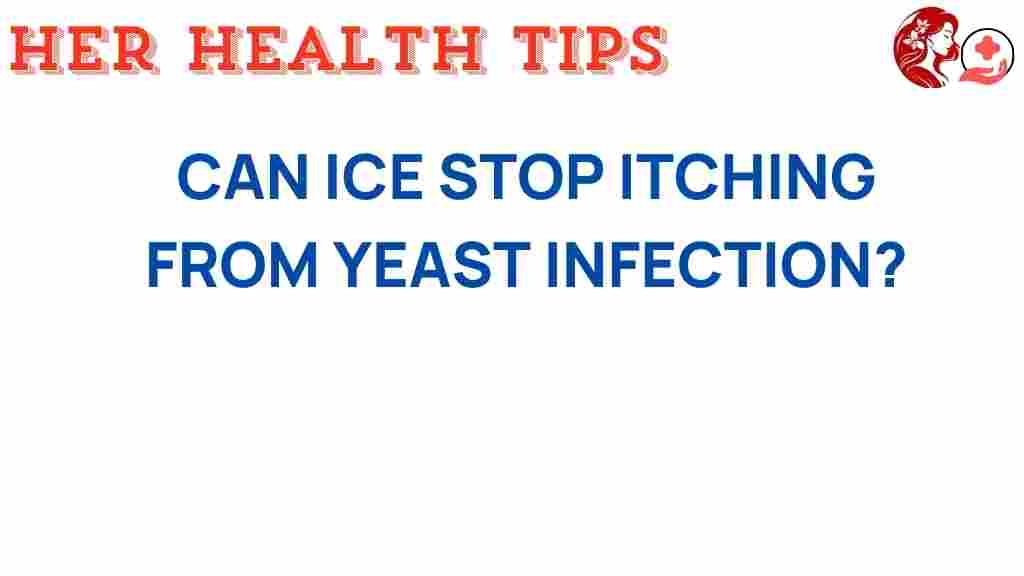Can Ice Provide Relief from Yeast Infection Itching?
When it comes to women’s health, yeast infections are a common yet uncomfortable issue that many experience. Symptoms often include intense itching, irritation, and discomfort in the vaginal area. While there are several treatments available, many women seek natural remedies for relief. One such approach gaining attention is the use of ice therapy. But can ice truly help alleviate the itching associated with a yeast infection? In this article, we will explore the effectiveness of ice therapy, how to use it, and other home remedies that can provide relief from yeast infection itching.
Understanding Yeast Infections
A yeast infection, medically known as vulvovaginal candidiasis, occurs when there is an overgrowth of the fungus Candida, which naturally lives in small amounts in the vagina. Various factors can trigger this overgrowth, including:
- Antibiotic use
- Hormonal changes
- High sugar diets
- Weakened immune systems
- Panty liners and tight clothing
Symptoms typically include:
- Itching and irritation in the vagina and vulva
- Redness and swelling
- Thick, white discharge that resembles cottage cheese
- Pain during intercourse
- Burning sensation during urination
What is Ice Therapy?
Ice therapy is a type of cooling treatment that involves applying ice or cold packs to the body to reduce inflammation and numb pain. This method has been used for various conditions, including sports injuries and migraines. Applying ice to the affected area can potentially provide temporary relief from itching and irritation associated with yeast infections.
How Does Ice Therapy Help with Itching Relief?
Ice therapy can help with itching relief in the following ways:
- Numbs the Area: The cold temperature can numb the nerve endings in the skin, reducing the sensation of itching.
- Reduces Inflammation: Ice can decrease blood flow to the area, which may help reduce swelling and inflammation.
- Provides Comfort: The cooling sensation can provide immediate relief from the discomfort associated with skin irritation.
How to Use Ice Therapy for Yeast Infection Itching
Here’s a step-by-step guide on how to use ice therapy effectively:
- Prepare the Ice: You can use ice cubes, a cold pack, or even a bag of frozen vegetables. Make sure to wrap the ice in a cloth or towel to prevent direct contact with the skin, which can lead to frostbite.
- Find a Comfortable Position: Lie down in a comfortable position where you can easily access the affected area.
- Apply the Ice: Place the wrapped ice on the irritated area for about 10-15 minutes. You can do this several times a day as needed.
- Monitor Your Skin: After removing the ice, check your skin for any adverse reactions. If you notice increased redness or irritation, discontinue use.
- Stay Dry: After using ice, ensure that the area is dry and avoid tight clothing to reduce moisture, which can exacerbate yeast infections.
Other Natural Remedies for Yeast Infection Itching
In addition to ice therapy, there are several other home remedies that can help alleviate yeast infection symptoms:
- Coconut Oil: Known for its antifungal properties, coconut oil can be applied topically to soothe irritation.
- Apple Cider Vinegar: Diluting apple cider vinegar in water and using it as a rinse may help restore the natural pH balance of the vagina.
- Probiotics: Taking probiotics can help balance the vaginal flora and prevent future infections.
- Plain Yogurt: Applying plain, unsweetened yogurt with live cultures can introduce beneficial bacteria.
- Garlic: Consuming garlic or using it as a topical treatment may also provide antifungal benefits.
When to See a Doctor
While ice therapy and natural remedies can provide relief, there are situations when it is essential to seek medical advice:
- If symptoms persist for more than a week despite treatment
- If you experience severe pain or swelling
- If you have recurrent yeast infections
- If you are unsure whether you have a yeast infection or another condition
Consulting with a healthcare provider will ensure you receive a proper diagnosis and treatment plan tailored to your needs. For more information on women’s health and yeast infections, you can visit this reliable source.
Troubleshooting Tips for Ice Therapy
While ice therapy can be beneficial, there are some troubleshooting tips to consider:
- Overuse: Avoid applying ice for too long to prevent skin damage. Stick to the recommended time of 10-15 minutes.
- Direct Contact: Always wrap ice in a cloth to avoid frostbite.
- Monitor Symptoms: If ice therapy does not provide relief, consider trying other remedies or consulting a healthcare professional.
Conclusion
In conclusion, ice therapy can be an effective method for providing relief from yeast infection itching. By numbing the area and reducing inflammation, it offers a simple, natural way to address discomfort. However, it is essential to combine this approach with other natural remedies and consult a healthcare professional if symptoms persist. Remember, maintaining good hygiene and a healthy lifestyle can play a significant role in preventing yeast infections. For more information on home remedies and women’s health, check out this link.
This article is in the category Conditions and created by HerHealthTips Team
